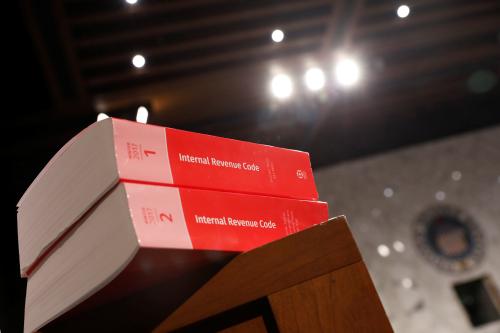Over the past 40 years, the distributions of income and wealth have grown increasingly unequal. In addition, there has been growing understanding that the United States faces a long-term fiscal shortfall that must be addressed, at least in part, by raising revenues. For these and other reasons, proposals to raise taxes on wealthy households have received increased attention in recent years. One approach to both reduce inequality and raise revenue is to reform the taxation of capital gains. One prominent proposal would be to tax capital gains as they accrue instead of waiting until an asset is sold, an approach sometimes known as “mark-to-market.”[1]
What is a capital gain?
A capital gain is the increase in the value of an asset over time. If you buy stock for $100 and its value rises to $300, you have accrued a capital gain of $200.[2] If you sell the stock for $300, the $200 gain is said to be “realized.” If you hold on to the stock, the gain is “unrealized.”
The overwhelming majority of realized capital gains go to the highest income households. In 2018, the top 1 percent of households ranked by income obtained 69 percent of realized long-term capital gains; the top 20 percent received 90 percent of the gains (Tax Policy Center 2018).
How do we tax capital gains now?
The federal income tax does not tax all capital gains. Rather, gains are taxed in the year an asset is sold, regardless of when the gains accrued. Unrealized, accrued capital gains are generally not considered taxable income. For example, if you bought an asset (e.g. a share of stock) for $100 ten years ago, and it’s worth $300 now and you sell it, your taxable capital gain would be $200 in the current year, and zero in the previous years.
This “taxation upon realization” approach has two advantages: relative ease of valuation and likelihood of investor liquidity. For the purpose of determining the capital gain, and then assessing tax liability, the value of the asset is simply the sale price. After realizing the gain, the selling investor should be able to use the money received for the asset to pay the capital gains tax.
Two other features of current capital gains taxation are noteworthy.
First, the tax rate on realized capital gains is lower than the tax rate on wages, if the asset was held for at least a year before selling. The top marginal tax rate on long-term capital gains is 23.8 percent, compared to a top marginal tax rate of 40.8 percent on wage income.[3]
Second, capital gains taxes on accrued capital gains are forgiven if the asset holder dies—the so-called “Angel of Death” loophole. The basis of an asset left to an heir is “stepped up” to the asset’s current value. Here’s an example: if your uncle bought an asset for $100 and sold it the day before he died at $300, he would owe capital gains tax on the $200 gain. If, instead, he held onto the asset until death and bequeathed it to you, you would receive the asset with a new basis of $300, not $100. No tax on the $200 capital gain is ever paid. If you eventually sell the asset for $350, you would have a basis of $300 and hence pay tax on capital gains of $50.
What are the problems with the way we tax capital gains now?
Although taxation on realization provides advantages with respect to liquidity and valuation, it also creates several problems. The underlying problem is that the current system does not tax a household’s economic income, which is the sum of the household’s consumption and the change in its wealth during the year. By this standard, all capital gains that occur in the year in question should be included—whether realized or unrealized.
Taxation on realization creates what is called a “lock-in” effect. When the tax rate on capital gains is constant with respect to the holding period, investors are financially rewarded for deferring the sale of the asset for as long as possible. Under taxation upon realization, the effective after-tax return rises with the length of the holding period, even if the pre-tax return and tax rates are constant.
“Taxation on realization creates what is called a ‘lock-in’ effect…[that] encourages investors to retain their assets when the economy would benefit from a change in investment.
For example, compare a stock producing a 10 percent annual return (and, let’s assume, no dividends) and a bond that produces 10 percent interest each year. Assume that both the capital gains tax rate and the ordinary income tax rate are 30 percent. After one year, the bond would generate a 7 percent after-tax return. Similarly, if the stock were sold and the capital gains tax were paid, the stock would generate the same after-tax return of 7 percent.
Over longer periods, however, the stock would perform better—that is, the effective tax rate on the stock would fall relative to the bond, because taxation upon realization delays the ultimate tax payment. For example, if the stock continued to accrue 10 percent per year and then was sold after 10 years, the effective return after paying capital gains taxes would be 7.8 percent, while the after-tax return on the bond would still be 7 percent.[4]
Lock-in encourages investors to retain their assets when the economy would benefit from a change in investment. In addition, lock-in subsidizes underperforming assets; investors will hold onto assets (say, an underperforming business) for longer than socially ideal to lower their effective tax rate.
Taxing capital gains on realization also drives tax sheltering. Investor use of existing assets as collateral for loans is one example of a tax shelter that deferral taxation allows. Loans on new assets, paid back with tax-deductible interest, are guaranteed by assets accruing capital gains. Investors can make a profit while paying off a loan, even if the pre-tax return on the newly purchased asset is the same as the interest rate on the loan, because of the collateral asset’s growth.
All of the practices described above are consequences of taxing realized capital gains instead of accrued gains. The other key features of the existing capital gains tax—preferred rates and basis step-up at death—interact with taxation on realization in problematic ways. The lower tax rates on capital gains than other forms of income encourage taxpayers to classify income as capital gains rather than as wages, and they make sheltering options more attractive. In addition, the “Angel of Death” loophole vastly increases the lock-in effect and appeal of sheltering.
Together, deferral taxation and basis step-up give investors enough discretion over whether and when to cash in assets that policymakers need to keep the capital gains rate relatively low. A variety of studies suggest that with deferral taxation and basis step-up, the revenue-maximizing tax rate is in the range of 28–35 percent (Gleckman 2019). At higher rates, investors would choose to hold on to assets rather than realize them, causing capital gains tax revenues to fall.[5]
What are the options for reform?
1. Eliminate step-up in basis at death
The simplest change would be to end basis step-up at death, eliminating the “Angel of Death” loophole. Eliminating basis step-up for heirs would result in a regime called “carryover basis.” The basis of an asset would not change when bequests are made. When the asset is later sold by an heir, the taxable basis would be the same as when the decedent owned it. Under a carryover basis system, capital gains tax would continue to be owed when the gain is realized. An asset that was purchased at $100, bequeathed and inherited at $300, and sold by the heir at $350 would have a capital gain of $250. Under the current system with step-up in basis, the capital gain would only be $50.
Shifting to carryover basis discourages lock-in and tax shelters. The Joint Committee on Taxation staff calculate that a policy ending basis step-up implemented this year would raise $104.9 billion over the next 10 years. In addition, curtailing tax avoidance would allow policymakers to raise the capital gains tax rate and generate increased revenues, without generating as much tax avoidance as would occur with a higher rate under the current system.
A carryover basis regime maintains the practice of taxing capital gains at realization and thus retains the advantages related to investor liquidity and ease of valuation.
One argument against carryover basis is that, in some cases, the taxpayer may not be able to document the basis of a long-held asset. This is easy enough to address. A carryover basis regime should stipulate a “default basis” (say, 10 percent of the sale price). If taxpayers can prove the basis is higher than the default basis, they would be entitled to do so. If taxpayers cannot or choose not to provide such records, the 10 percent basis rule would apply, and the capital gain would be deemed to be 90 percent of the sale price.
2. Tax capital gains at death
A somewhat more aggressive reform would be to tax capital gains at death. Under this regime, death would be treated as if the holder sold the asset. The decedent would owe capital gains tax on unrealized capital gains accrued during his or her lifetime. The heir would then inherit the asset at its current value through basis step-up.
For example, if an investor with an asset basis of $100 were to die when the asset’s marketable value was $300, his estate would pay capital gains tax (as well as any estate tax owed) on the $200 gain. The heir to this asset would have the basis stepped up to $300 – the value of the asset at the time of inheritance.
Relative to basis carryover, taxing unrealized gains raises more revenue, reduces sheltering opportunities, and reduces the lock-in effect. Lily Batchelder and David Kamin (2019), using JCT projections (2016), estimate that taxing accrued gains at death and raising the capital gains tax rate to 28 percent would bring in $290 billion between 2021 and 2030.
However, taxing gains at death creates challenges for investors that eliminating basis step-up and moving to carryover basis does not. After death, an investor’s estate owes tax without receiving a payment for an asset and may find it difficult to pay the tax on time. This could be addressed either by would-be decedents buying life insurance to cover the liability and/or allowing estates to pay the tax over a period of time (e.g., five or ten years). Also, unlike the carryover basis system, a capital gains tax at death requires valuation of some privately-held and non-marketable assets, like family businesses or art, that may be difficult to value.
3. Tax capital gains on an accrual basis
A more far-reaching reform would be to tax capital gains not just at death, but every year as they accrue. Under an accrual tax, sometimes called a “mark-to-market” system, investors would pay tax on their capital gains every year, regardless of whether the gains were realized or not.
“Accrual taxation represents…a move away from the realization principle… It would eliminate the lock-in effect, the use of capital-gains-bearing assets as tax shelters, and most of the incentive to shift labor income into capital gains.”
Accrual taxation represents a major break from the current system as a move away from the realization principle, and it has several advantages. It would eliminate the lock-in effect, the use of capital-gains-bearing assets as tax shelters, and most of the incentive to shift labor income into capital gains. Because it restricts avoidance, accrual taxation would allow for a significantly higher tax rate on capital gains without inducing significant avoidance. Accrual taxation brings the tax system in line with the basic definition of income outlined above. It would increase the tax base and thus raise revenues. Using Survey of Consumer Finance data, Batchelder and Kamin calculate that accrual taxation (a) on marketable assets only and (b) limited to the top 1 percent of households would raise $1.7 trillion over ten years, even after allowing for a 15 percent avoidance rate.
Accrual taxation, however, is not without problems. First, like taxing capital gains at death, this reform option raises liquidity concerns. To address this concern, asset holders could pay their capital gains tax liability over 5 or 10 years (Toder and Viard 2016).
The valuation problems for non-marketable assets are similar to those that arise under taxation at death, but they are more difficult because under accrual taxation the assets must be valued every year, which would be quite difficult for taxpayers and the IRS. The solution would be to couple accrual taxation of marketable assets with retrospective taxation (as described below) of non-marketable assets. Kamin and Batchelder estimate this coupling would increase tax revenue by $400 billion, even if retrospective taxation only applied to the top 1 percent.
While mark-to-market is straightforward for gains in marketable assets, it becomes more complex for economic downturns and losses. For example, suppose Warren Buffett owns $50 billion in stock, and suppose that a recession causes the stock market to fall by 10 percent (the classic definition of a bear market), and that capital gains are taxed as ordinary income with a top rate of about 40 percent. In that case, the $5 billion decline works out to $2 billion in negative income for tax purposes (40 percent of $5 billion is $2 billion). So, would the government owe Buffett $2 billion? To avoid that obviously politically unappealing prospect, investors with losses could be allowed to apply them against future capital gains. The value of the loss allowed to be carried forward could be unlimited in value and duration or limited in either. Presently, capital losses can offset $3,000 of other taxable income in a year, and excess losses can be carried forward for deductions in following years.
4. Retrospective taxation
Retrospective taxation (Auerbach 1988) offers a way to retain taxing capital gains at realization but eliminate the lock-in effect and associated sheltering problems that deferral creates.
Under the current system, the statutory tax rate on long-term capital gains is constant as the holding period lengthens. As a result, the effective tax rate on accrued capital gains falls as the holding period rises—this is the lock-in effect. To make the effective tax rate on accrued capital gains constant as the holding period rises, eliminating the lock-in effect, the statutory tax rate should rise as the holding period lengthens.
The capital gains tax rate can be set as a function of the final sale price, the risk-free interest rate, the investor’s marginal tax rate, and the holding period. This system is applicable to both marketable and non-marketable assets, but it is particularly valuable for non-marketable assets, as it eliminates the valuation problems that arise there. It also resolves the liquidity problem that plagues accrual taxation.
Where to from here?
The taxation of capital gains is a live issue in the Democratic primaries. Joe Biden, Cory Booker, Julián Castro, and Elizabeth Warren have called for taxing capital gains at death. Castro, Warren, and Booker want to tax capital gains on an accrual basis. Booker and Castro, before dropping out of the race, voiced support for retrospective taxation or related policies. Reforming the capital gains tax can address inequalities and inefficiencies of the current system, and it appears likely that the focus on the issue will continue into 2020.
For information purposes, this is the matrix we have been working off of.
| System | Lock-in/Sheltering | Angel of Death Loophole | Liquidity problem | Valuation problems | |
| (1) | Current system | A problem | Present | Minimal | Minimal |
| (2) | End step up/move to carryover basis | Less of a problem | Removed | Minimal | Slightly larger, but easily solvable with a default basis rule |
| (3) | Tax capital gains at death | Even less of a problem | Removed |
Somewhat Larger than (2) |
Somewhat smaller than (2) |
| (4) | Accrual taxation for marketable assets | Virtually eliminated | Removed | Substantial | Same as (1) |
| (5) | Accrual taxation for nonmarketable assets | Virtually eliminated | Removed | Substantial | Substantial |
| (6) | Retrospective taxation | Virtually eliminated | Removed | Same as (1) | Same as (1) |
[1] The term “mark-to-market” means that, for tax purposes, an asset’s reported value can be marked, or tied, to its market value.[2] More technically, a capital gain is the difference between an asset’s current value and its “basis.” The basis is the cost to the owner: the sum of the purchase price, commissions, and fees, less any deprecation of the asset over time.[3] Realized capital gains face a top statutory marginal income tax rate of 20 percent plus a supplemental net investment income tax rate of 3.8 percent, for a combined total of 23.8 percent. Wages face a top marginal tax rate of 37 percent, plus a Medicare tax rate of 2.9 percent and a supplemental tax of 0.9 percent, for a combined rate of 40.8 percent[4] The calculation for the after-tax value of the stock is given by the expression {((1+r)**T)-1)}(1-t) + 1, where r is the annual pre-tax rate of return, T is the holding period, and t is the capital gains tax rate. The average annual after-tax rate of return is that expression taken to the 1/T power, less 1.[5] Another issue is that capital gains are not indexed for inflation. For example, if you bought an asset for $100 a few years ago and it is worth $300 now, the nominal capital gain is $200. But if the price level had doubled during the time since you bought the asset, the real gain would only be $100. The current system taxes the nominal gain. This is not ideal, but indexing capital gains for inflation, without indexing other forms of capital income and capital expense, would create numerous distortions and inconsistencies in the tax system and increase sheltering. Given how low inflation has been in recent years and given the complexity of indexing all forms of capital income and expense, this issue can be kept on hold for now.
The Brookings Institution is committed to quality, independence, and impact.
We are supported by a diverse array of funders. In line with our values and policies, each Brookings publication represents the sole views of its author(s).







Commentary
How could changing capital gains taxes raise more revenue?
January 14, 2020